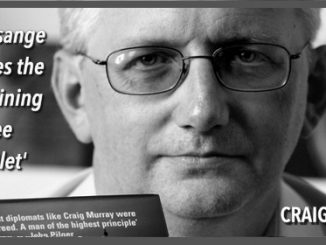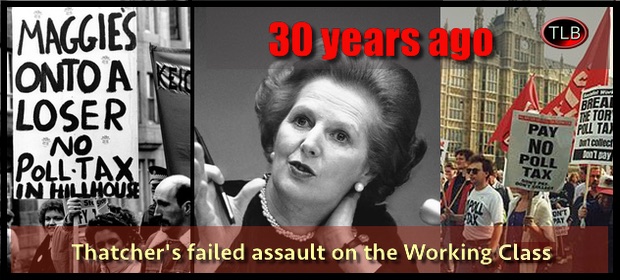
30 Years Ago Thatcher Foisted Her Poll Tax on Scotland – We Fought Her and Won
TOMMY SHERIDAN
It was never a UK wide roll out as the new tax was not introduced in Northern Ireland. The country of Scotland, which had rejected Thatcher in 1979, 1983 and 1987, was chosen as the proverbial Guinea Pig for her Flagship Policy of domestic rates abolition in favour of a flat-rate head tax. It was to prove the biggest mistake in her political career.
Context is everything when we come to view events in history, both recent and ancient. Working class writers and participants in struggle should always be encouraged to document their experiences lest the critical role played by ordinary people in the advance of society is forgotten, or more likely hidden. The Poll Tax revolt was a mass working class rebellion against a Prime Minister who had appeared unbeatable and unstoppable. She had been daubed ‘The Iron Lady’ across Europe due to her reputation for fighting political foes domestically and internationally.
Mrs Thatcher became the UK’s first female Prime Minister in 1979 on the back of significant industrial unrest caused by the sitting Labour Government’s policy of wage restraint on lowly paid public workers who had no alternative but to fight for better pay. What became known as the ‘Winter of Discontent’ over 1978-1979 was the breeding ground for Thatcher to portray herself as a ‘strong’ woman who could sort out 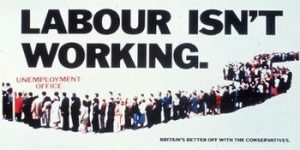 Britain’s problems, particularly high unemployment. The poster that defined that election was ‘LABOUR ISN’T WORKING’ with a long queue of people depicted outside an unemployment office. The official rate of unemployment was sitting at 6%.
Britain’s problems, particularly high unemployment. The poster that defined that election was ‘LABOUR ISN’T WORKING’ with a long queue of people depicted outside an unemployment office. The official rate of unemployment was sitting at 6%.
Thatcher was a brutal monetarist who believed in cutting taxes for the rich and wealthy on the basis that some of the wealth created would eventually ‘trickle down’ to the poor and low paid. It is a theory as robust as the tooth fairy tales, but slick advertising and promotion convinced many it would work. Deciding to turn the UK from a manufacturer of goods into a supplier of services, Thatcher began a de-industrialisation process that saw steelworks, shipyards, coal mines and car factories reduced in size and often closed. The Finance Capital wing of the Tory party was dominant. The market trading yuppies and expert sellers of stocks and shares were in the ascendancy. Lots of money was being made but nothing of value was being created.
From 1979 to 1982 Britain was subjected to a concerted policy of industrial vandalism under the cold and callous rule of Thatcher. The high unemployment of 6% in 1979, which gave rise to the ‘Labour Isn’t Working’ poster, became mild compared to the 12% unemployment rate under Thatcher. She and her Government were increasingly unpopular and heading for electoral annihilation. They had fallen to only 30% support in opinion polls. Talk of deposing her from leadership of the Tories was open and constant. Then an Argentinian General struggling to stay in power domestically handed Thatcher the political lifeline she was desperate for.
On April 2nd 1982 Argentina invaded and occupied a small British colony in the South Atlantic to lay claim to sovereignty over the Falkland Islands, which they had for years claimed as part of their territory.
[In the period leading up to the invasion-and, in particular, following the transfer of power between the military dictators General Jorge Rafael Videla and General Roberto Eduardo Viola late in March 1981-Argentina had been in the midst of a devastating economic stagnation and large-scale civil unrest against 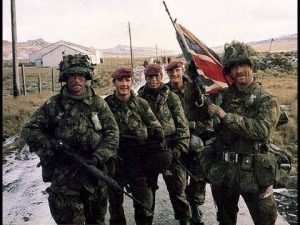 the military junta that had been governing the country since 1976. In December 1981 there was a further change in the Argentine military regime, bringing to office a new junta headed by General Leopoldo Galtieri (acting president), Air Brigadier Basilio Lami Dozo and Admiral Jorge Anaya. Anaya was the main architect and supporter of a military solution for the long-standing claim over the islands, calculating that the United Kingdom would never respond militarily. That was a serious error of judgement.]
the military junta that had been governing the country since 1976. In December 1981 there was a further change in the Argentine military regime, bringing to office a new junta headed by General Leopoldo Galtieri (acting president), Air Brigadier Basilio Lami Dozo and Admiral Jorge Anaya. Anaya was the main architect and supporter of a military solution for the long-standing claim over the islands, calculating that the United Kingdom would never respond militarily. That was a serious error of judgement.]
Within 3 days of the Falklands invasion, the unpopular Thatcher despatched British Navy ships to ‘liberate’ the British colony from foreign invasion. Over a ten week war that claimed the lives of almost 650 Argentinian soldiers and 255 British military personnel, the Falklands Islands were returned to British status and Thatcher’s stock in the UK was improved massively, with the aid of friendly Tory tabloids, who portrayed her as a strong war leader. Even the sinking of the Argentinian ARA General Belgrano, an old former US ship launched in 1938 but decommissioned and sold to Argentina in 1946, as it sailed miles outside the designated Conflict Exclusion Zone and posed no threat to Britain’s naval fleet, did not dent the jingoistic fervour which Thatcher bathed in.
 Her order to have the Belgrano sunk (pictured) with the consequent loss of 323 young Argentinian sea cadet lives was in reality a war crime, but the bounce it gave Thatcher saw her opinion poll ratings soar and a 2nd successive electoral victory secured in 1983.
Her order to have the Belgrano sunk (pictured) with the consequent loss of 323 young Argentinian sea cadet lives was in reality a war crime, but the bounce it gave Thatcher saw her opinion poll ratings soar and a 2nd successive electoral victory secured in 1983.
With victories against striking health service workers, steel workers and car workers in her bag, Thatcher turned her attention to the warriors of the trade union movement in the shape of the National Union of Mineworkers (NUM). The Ridley Plan of 1978 reveals how she and the Tories planned meticulously to take down the miners’ union and destroy coal mining communities across the UK. Anyone who doubts the deviousness and politically motivated hatred against the organised working class of the Tory party should acquaint themselves with the Ridley Report.
That titanic industrial battle, appropriately described as a ‘civil war without the guns’, kicked off in March 1984 and lasted 12 long months during which time the might of the British State was mobilised and unleashed against the men and women of mining families and the NUM, whose only crime was to try and defend their jobs, pits and communities. Thatcher eventually won but records subsequently revealed show she was days from defeat at one point in the battle and had the trade union leaders at the top of the British Trades Union Congress (TUC) shown more guts and organised real solidarity, she would have lost and years of brutal Tory policies and job losses could have been avoided.
Thatcher herself considered defeating the NUM and the trade union movement as a whole a moral imperative and more important than defeating General Galtieri:
“We had to fight the enemy without in the Falklands. We always have to be aware of the enemy within, which is much more difficult to fight and more dangerous to liberty.”
On the back of her victory over the miners and faced with the ineffectual Labour leader Neil Kinnock (pictured), 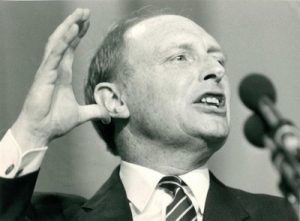 who failed to back the miners’ strike 100% but was prepared to attack Labour councils who fought the Thatcher cuts and launch witch-hunts against socialists within his party, Thatcher won an historic third successive General Election victory in 1987. In Scotland her party was decimated from 21 MPs to only 10 and managed only 24% of the votes cast, but across the UK she won 42% of the votes and a 102 Parliamentary seat majority. She had already decided to abolish domestic rates and replace them with her Community Charge.
who failed to back the miners’ strike 100% but was prepared to attack Labour councils who fought the Thatcher cuts and launch witch-hunts against socialists within his party, Thatcher won an historic third successive General Election victory in 1987. In Scotland her party was decimated from 21 MPs to only 10 and managed only 24% of the votes cast, but across the UK she won 42% of the votes and a 102 Parliamentary seat majority. She had already decided to abolish domestic rates and replace them with her Community Charge.
Showing her contempt for Scotland, she decided to trial her new scheme here first, despite her democratic mandate being slashed by the loss of more than half her MPs in the country.
This is the essential background and context to the Poll Tax battle. An emboldened and battle hardened Thatcher prepared to put her ‘Iron Lady’ reputation on the line to push through her Flagship Poll Tax policy. She was in for a shock.
Before 1989 only the wealthiest in Scotland would be able to tell you what their rates bill was. It was the rateable value on your home, which meant it reflected the value of the house. So basically the bigger the house you lived in, the larger the rates bill was. In working class housing estates and villages across Scotland, the rates bill was lumped in with the rent as most people lived in council homes. People knew what the rent was, but few bothered with the rates element as it was relatively small.
Only the people in big houses bothered about the rates, but they were the very ones most likely to vote Tory, so scrapping rates and replacing them with a flat-rate poll tax levied on every adult in the household was popular with the wealthy but a disaster for the poorest.
The poll tax was in effect a transfer of wealth from the poorest to the richest. The Duke in his Castle would pay less in poll tax than rates, but the dustman in his council home would pay more. Average households with two parents and two adult children over 18 years of age faced poll tax bills 3 and 4 times greater than the previous rates bills. On the back of years of factory closures, job losses and welfare cut backs, it really was the breaking point for many.
I and thousands like me across Scotland engaged in anti-poll tax activities throughout 1988. We studied the Government literature and knew we were being sold a pig in a poke. The rich were happy enough, but ordinary families faced a full frontal assault on their already strained disposable incomes. It is a fact of the campaign that the single biggest recruiting sergeant to the ranks of the refusal-to-pay army was poverty, not fine speeches.
In housing estates and villages across Scotland, there was a determined attempt to try and build a 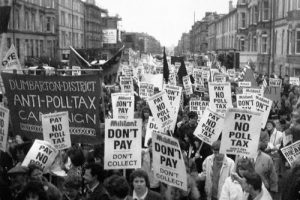 campaign of mass civil disobedience against Thatcher’s poll tax. We had tried petitions, letter writing campaigns, marches and the bloody nose inflicted on her at the ballot box in Scotland in 1987. None of it mattered to her and her various lieutenants in Scotland, who were all determined to press on despite the hardship the poll tax would bring.
campaign of mass civil disobedience against Thatcher’s poll tax. We had tried petitions, letter writing campaigns, marches and the bloody nose inflicted on her at the ballot box in Scotland in 1987. None of it mattered to her and her various lieutenants in Scotland, who were all determined to press on despite the hardship the poll tax would bring.
I was fortunate to be involved with a political organisation within the Labour Party at the time. I was a member of the Militant Tendency, which was committed to fighting for a genuine socialist party and the promotion of socialist policies. Just like the Labour Friends of Israel campaign within the Labour Party today exists to oppose socialists and socialist policies, so Militant in the 1980’s was committed to reclaiming the party to its socialist roots.
The strategy of mass civil disobedience through mass refusal to pay the Tory poll tax was discussed, debated and devised in hundreds of local and national meetings before being taken into communities and proposed. The response in many meetings was similar; ‘How can we possibly beat Thatcher, she has taken on the miners and Galtieri’? ‘She is the Iron Lady’. My riposte was to remind the audience that up until now, Thatcher had isolated her targets and taken them on individually. Now she was attacking the whole of the Scottish working class at once. If we united against her through mass civil disobedience, we could win. Some were not convinced we could win, but many were prepared to fight.
The official movement of the trade unions and Labour Party all agreed the poll tax was a disgrace. ‘Unfair, unjust and immoral’ was the common refrain. But their opposition was to be in words, not actions. Frightened of advocating law breaking on a mass scale and the inevitable criticism they would receive from the media, the Labour Party and trade union movement united in opposition to the poll tax AND mass civil disobedience against it. Had these people not read their own history? The trade union movement would never have been formed without the illegal actions of the six Dorset agricultural labourers who defied existing laws to form a friendly society and swear oaths of allegiance to one and other. They were arrested and forcibly deported to Australia, but they became known as the Tolpuddle Martyrs and their actions paved the way for organised trade unionism.
What if the suffragette movement had refrained from civil disobedience in pursuit of the right to vote? Women and women’s rights would still be in the dark ages without the courage, vision and illegal civil disobedience actions of Emmeline Pankhurst and her Woman’s Social and Political Union. Thomas Jefferson was one of the founders of the American Declaration of Independence. It is he who credited with the saying:
“When injustice becomes law, resistance becomes duty”
We in the anti-poll tax movement drew inspiration from the Poplar Councillors in the poor borough of East London in 1921, who were prepared to break the law and be sent to prison rather than pass on new rates taxes to the poor people they were elected to represent. Led by George Lansbury the slogan they adopted was: “Better to break the law than break the poor”.
That same slogan had been adopted and put into practice by the heroic 47 Liverpool Labour councillors who fought Thatcher’s Local Government cuts in 1984/85 and won, before being sequestrated and removed from office by the courts in 1985/86. Instead of implementing millions of pounds of cuts, these councillors built new homes, new sports centres and created 5,000 new jobs. They were on the wrong side of the law because they set needs budgets instead of cuts budgets, but they were on the right side of the people.
Through a combination of mass leaflet drops, hundreds of public meetings, impromptu street meetings and scores of marches and rallies, the grassroots anti-poll tax campaign grew from strength to strength and propelled hundreds of ordinary people into the role of community leadership. We were advocating that households across Scotland refuse to pay the ‘unfair, unjust and immoral’ poll tax, and we knew the only way we could win was strength in numbers. Prison was not an option for non-payment in Scotland, but officers of the court (known as sheriff officers) were empowered to forcibly enter the homes of poll tax debtors to remove their belongings and sell them at public auctions, known as warrant sales. It was a humiliating experience and ordinary people were frightened of being subjected to them. However through a combination of guts, energy, confidence and a will to succeed, a mass army of non-payers was recruited and within six months of the tax being introduced in Scotland, the councils expecting to collect the tax were reporting serious collection problems. Sadly most of those councils were Labour councils, and rather than refuse to collect the tax and assist the rebellion, these councillors chose the cowardly path of acquiescence and meek surrender, sending out sheriff officers to collect a tax they themselves had admitted months previously was ‘unfair, unjust and immoral’. If the poll tax was ‘immoral’, as it surely was, then why the hell were Labour councils helping the Tories to implement it?
Throughout the whole of 1989 and running up to the introduction of the tax in April 1990, my life was a whirlwind of meetings and rallies in Scotland, England and Wales. I was elected to lead the Scottish Anti-Poll Tax Federation and chair the All- Britain Anti-Poll Tax Federation. We organised two major anti-poll tax rallies to coincide on Saturday 31st March 1990. To celebrate one year of defiance and non-payment in Scotland and to call for mass non-payment in England and Wales. I addressed the 40,000 strong event in Glasgow before flying down to London to address the 200,000 that had gathered from all over to march through London against the tax.
The event in Glasgow was joyous and we were able to highlight official non-payment figures which showed one million non-payers. The event in London turned nasty when police officers on horseback attacked the marchers in Trafalgar Square, and a riot ensued with over 300 arrests and carnage in the city centre. The Iron Lady was now facing street riots in he own capital city. Her reputation was in tatters and it was clear the mass civil disobedience kicked off in Scotland would spread like wildfire in England and Wales.
Within 12 months of the poll tax introduction in England and Wales, official non-payment  figures reached 14 million. The tax had become ‘uncollectable’, as new Prime Minister John Major (pictured) would later describe it, and it was the grassroots anti-poll tax campaign that made it uncollectable. The woman who pinned her considerable reputation on the poll tax in April 1989 was forced to resign in floods of tears by November 1990. The anti-poll tax campaign assumed the role of David in the David versus Goliath battle and brought Thatcher to heel.
figures reached 14 million. The tax had become ‘uncollectable’, as new Prime Minister John Major (pictured) would later describe it, and it was the grassroots anti-poll tax campaign that made it uncollectable. The woman who pinned her considerable reputation on the poll tax in April 1989 was forced to resign in floods of tears by November 1990. The anti-poll tax campaign assumed the role of David in the David versus Goliath battle and brought Thatcher to heel.
The Iron Lady was melted down and shipped off to the political knackers yard where she belonged, and it was the poll tax mass civil disobedience campaign which applied the necessary heat to melt her down. Collectively the volunteer army of poll tax non-payers sunk Thatcher’s Flagship and forced her to go down with her ship. Good riddance to her and all she stood for. Next Saturday in Glasgow I will address a 30 Year Celebration of the Poll Tax Battle. We will remember the courage and determination of many who fought and are no longer with us but we will also remember the strength of mass civil disobedience when it is harnessed and organised to achieve certain objectives.
************
Original article
ER recommends other articles by Sputnik News




